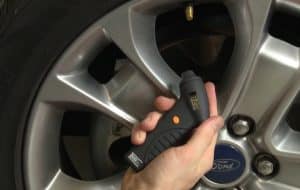If you’re one of the 60% of drivers who regularly check their tire pressures, you can stop working right now. Tire pressure monitoring systems (TPMS) are a common safety precaution, and they can help prevent costly repairs and even accidents.
In this article, you’ll learn the basics of TPMS, discover how they work, and find out what you need to know before buying one. So, let’s get started!
What Is a Tire Pressure Monitoring System?

A tire pressure monitoring system(TPMS) is a device that monitors the air pressure in a vehicle’s tires. It’s common for drivers to forget to check their tire pressure regularly before heading out on the road. A TPMS uses a warning system to alert the driver to low tire pressure.
The driver can respond by adjusting the tire pressure using a specific gauge on the dash. If you drive long miles weekly, you may lose track of how much air is in your tires and take preventative measures too late.
How Does It Work?

A TPMS works through the use of sensors on each wheel. The sensors monitor each tire’s air pressure. They transmit their data to a display unit, which is usually located on the dashboard. If a tire’s pressure drops or rises, it transmits an alert to the display unit.
When a wheel’s pressure drops too low, it will flash an alert on the dash for attention. Also, if any of your tires lose air pressure faster than normal, you’ll get an alert. It displays the warning on an indicator light on your dash.
What Are the Benefits of A TPMS?
A TPMS comes in handy during a tire change. If you’re changing your tires, checking your air pressure before you get on the road is a good idea. A TPMS will alert you if your tire pressure is too low or has a pressure imbalance. Also, it alerts you of unusual tire pressures on the road. TPMS warns you if your tires are properly inflated so you can respond. For example, it can warn you of flat, overheating or damaged wheels.
How Long Does a TPMS Sensor Last?
Tire Pressure Monitoring System lifespan depends on how much use the sensors receive. Average lifespan of a TPMS sensor is about 5 years. If you drive a lot for long distances, then the sensors can use for more than 5 years before they need to be replaced.
As the average lifespan of a TPMS sensor comes to an end, multiple sensors will start to malfunction at once. You may notice that the warning light on your dash isn’t flashing anymore. If you notice issues with your TPMS, you can replace the sensors to fix your TPMS and prevent future problems.
How Do You Reset Perform TPMS?
TPMS reset is a new task added to the list of future services done with vehicle experts and mechanics. The system is not fully developed and still needs some work to function fully and efficiently. New cars are still released every year, and each car has a different reset procedure.
It is not recommended that people perform the TPMS reset themselves because there is a good chance they will cause more damage to the system. You can wait until you have taken your vehicle to a technician or mechanic who can safely perform the reset on your vehicle for you.
What Happens When The TPMS Battery Dies?
The TPMS’s battery transmits pressure data to the instrument cluster. The battery may die or lose its charge after about 5 years of use. You can use a scanner or a voltmeter to check the voltage of the TPMS battery and see if it is still operating properly. If the battery is dead, the TPMS will not be able to operate at all.
To check for a dead battery, turn on the ignition and remove your key from the ignition. Place a voltmeter between the TPMS and your car’s battery. If there’s a voltage differential, consult your owner’s manual for replacement instructions.
FAQs
Can you turn off the TPMS light with OBD2 Scanner?
Yes, you can turn off the TPMS light with an OBD2 scanner. The OBD2 scanner with TPMS can check your battery voltage and then turn them off. However, if you have a car that has TPMS, the battery voltage will be different if it is in use. The OBD2 scanner will not turn off your TPMS if the voltage is different.
How to Replace the TPMS Battery?
The easiest way to replace the battery is to purchase a new one from an automotive store and install it yourself. In addition, you can call a professional who will install the new battery for you. If you don’t want to mess with the TPMS, you can call a professional who will install the new battery.
Can You Replace a TPMS by Yourself?
It depends on the size of your vehicle. If your car’s wheel rim is wider than 17″, it will be difficult to replace the TPMS yourself. You can try, but you may damage the TPMS or your vehicle if you don’t know what you’re doing. If you’re not willing to pay a mechanic to repair, an auto parts store should have what you need to do it yourself.
How Much Does It Cost to Replace the TPMS Battery?
It depends on the type of TPMS you have in your car. The sports cars will have more expensive sensors than economy cars. The cost to replace a battery for most TPMS is about $40 – $70.
Final Discussion
In the end discussion, you can use the TPMS tool to help monitor the changing tire pressure on the street. When you can use a TPMS to monitor your tire pressure, then you can control the tire before it becomes a problem.
If left unchecked, poor tire condition and pressure monitoring can cause damage to the tires and even to your car.
So, you can save money and improve vehicle maintenance with TPMS and OBD2 scanners.

As a mechanical engineer, it’s easy for David to explain the functionality of the tool. David test most of the tools before writing a review. its help him to learn something new and suggest the best product for you.





